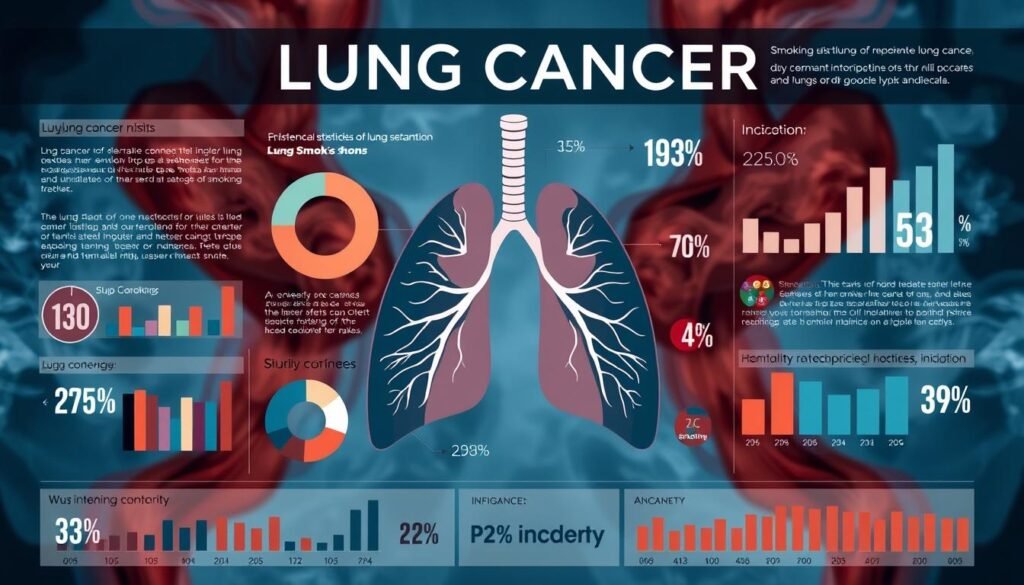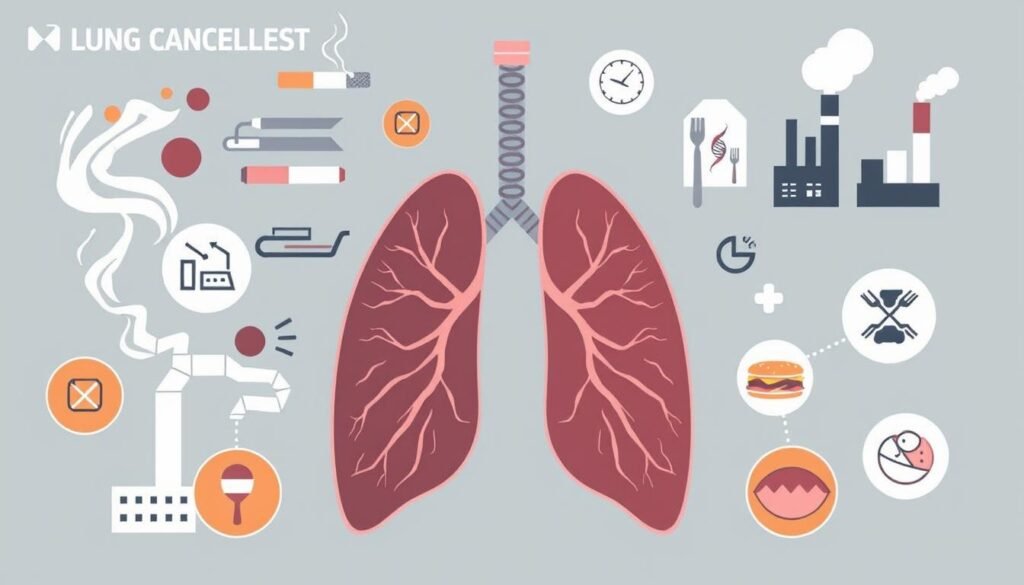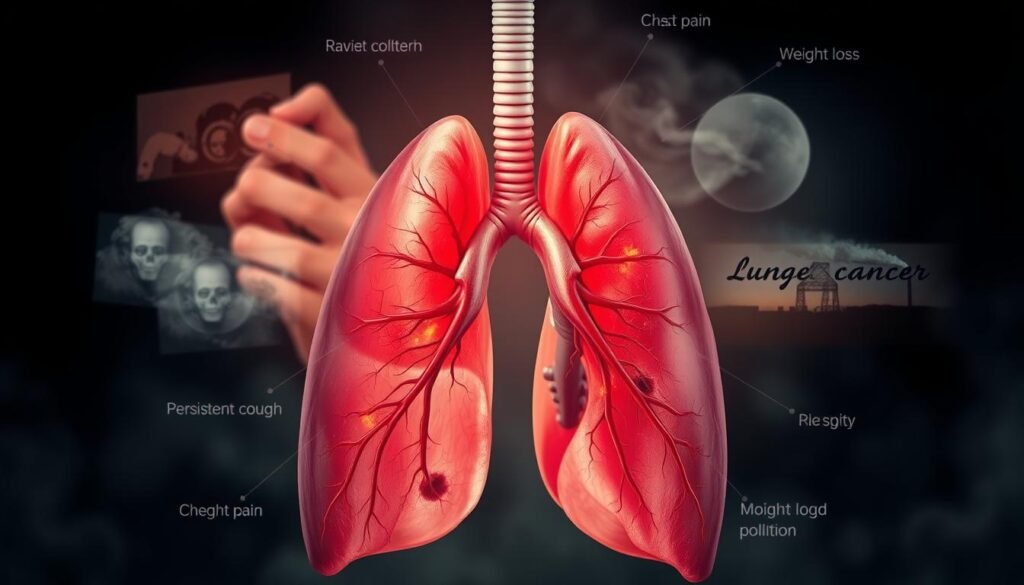About 80% to 90% of lung cancer deaths in the U.S. are due to smoking. This fact shows how our choices impact lung cancer’s causes and prevention. Knowing the risk factors and symptoms is key for early detection and prevention. Most cases come from things we can change, so spreading the word can help lower these high numbers.
This article offers deep insights into lung cancer’s risk factors and symptoms. It also covers important prevention info. It’s crucial to know the risks smoking brings. But, we also need to talk about other risks like the environment and family history. Teaching and raising awareness play a huge role in tackling the top cause of cancer deaths.
Key Takeaways
- Smoking is responsible for 80-90% of lung cancer deaths.
- Understanding risk factors can significantly aid in lung cancer prevention.
- Environmental toxins also pose significant lung cancer risks.
- A family history of lung cancer increases one’s chances significantly.
- Awareness of early symptoms can lead to earlier detection and treatment.
- Secondhand smoke is a significant risk factor for non-smokers.
Understanding Lung Cancer
Lung cancer starts with abnormal growth in lung cells. This disrupts normal breathing. It mainly comes in two types: small cell and non-small cell lung cancer. Small cell is mostly in heavy smokers. Knowing the causes of lung cancer is key to prevent and handle it.
Spotting lung cancer early is hard since symptoms can be silent at first. Those affected might later face breathlessness, constant coughing, and blood in sputum. If not treated, lung cancer can reach other body parts, like the brain and bones. This makes it critical to act swiftly.
Many risk factors can raise one’s chance of getting lung cancer. Important ones include:
- Smoking and secondhand smoke exposure
- Past chest radiation therapy
- Radon gas in homes and places
- Exposure to harmful work materials, like asbestos
- Having lung cancer in the family
Stopping smoking is a strong defense against lung cancer. While prevention isn’t 100% sure, healthy living supports lung well-being. Grasping lung cancer’s complexities helps people make informed choices, linking knowledge to action.
| Type of Lung Cancer | Typical Cause | Symptoms |
|---|---|---|
| Small Cell Lung Cancer | Heavy smoking history | Shortness of breath, cough, chest pain |
| Non-Small Cell Lung Cancer | Smoking, air pollution, family history | Weight loss, fatigue, recurring respiratory infections |
Key Statistics on Lung Cancer
Lung cancer is a major health concern, causing about 25% of all cancer deaths. This fact highlights the need for more awareness and action. In the U.S., around 234,580 new lung cancer cases are expected annually by 2024. This accounts for 11.7% of all new cancer cases. Sadly, about 125,070 people may die from lung cancer in the same year. This will represent 20.4% of all cancer deaths.

In the U.S., someone is diagnosed with lung cancer every two minutes. This shows how important early detection is. The five-year survival rate for lung cancer has gone up to 26.7% between 2014 and 2020. This improvement is mostly thanks to better screening and treatment, like low-dose computed tomography (LDCT). LDCT scans can reduce lung cancer death rates by up to 20%.
Yet, only 16.0% of those who should get screened actually do it. This shows we need to do better. Screening rates differ from state to state, with Rhode Island at 28.6% and Wyoming at just 8.6%. Every day, more than 361 people in the U.S. die from lung cancer. This stresses the urgency to boost screening and raise awareness.
| Statistic | Value |
|---|---|
| Estimated New Cases (2024) | 234,580 |
| Percentage of All New Cancer Cases | 11.7% |
| Estimated Deaths (2024) | 125,070 |
| Percentage of All Cancer Deaths | 20.4% |
| 5-Year Relative Survival Rate (2014–2020) | 26.7% |
| Death Rate per 100,000 | 32.4 |
| Lifetime Risk of Developing Lung Cancer | 5.7% |
About 85% of lung cancer cases are linked to smoking. This shows how crucial prevention is in fighting this disease. But, lung cancer can affect non-smokers too. This highlights the need to understand risk factors and support healthy lifestyle choices. These statistics on lung cancer survival and death underline the fight against a disease that claims many lives each year. For more information, check out this detailed resource on lung cancer statistics.
Primary Risk Factors for Lung Cancer
Lung cancer risk factors include things we can and can’t control. Smoking is a major controllable risk. It causes about 72% of lung cancer cases in Canada. Smokers are 22 times more likely to die from lung cancer than non-smokers.
Radon exposure is a big risk for non-smokers. It’s also the second biggest risk for smokers. Radon in homes causes about 21,000 lung cancer deaths a year in the U.S. Being around harmful chemicals like arsenic and asbestos also increases risk. Smokers working with these substances are at even higher risk.

Environmental factors also play a role. This includes air pollution and indoor pollutants from cooking and heating. People with health issues like COPD are at higher risk. Radiation therapy for other cancers also increases risk, especially for smokers.
A family history of lung cancer, genetic changes, and chronic lung diseases raise risk too. Being around secondhand smoke can also lead to lung cancer. Kids exposed to smoke are more at risk.
To learn about lung cancer causes, click on this link. It’s important to know and reduce these risks to protect our lung health.
Risk Factors Lung Cancer Symptoms
Understanding lung cancer’s risk factors is key to prevention. Smoking is the top cause of this illness. It greatly raises the chance of getting lung cancer, showing why it’s critical to link smoking and this disease.
Impact of Smoking on Lung Cancer Risks
About 85% of lung cancer cases come from smoking. This fact points out its significant danger. Smokers are 15 to 30 times more likely to develop lung cancer than non-smokers. Over time, the toxins in cigarettes harm lung cells, which can lead to tumors. In Australia, smoking causes most of the 15,500 lung cancer cases diagnosed each year.
Secondhand Smoke: A Hidden Danger
Secondhand smoke also poses a serious risk, affecting those who don’t smoke themselves. Being around a smoker can make your risk of lung cancer go up by 30%. Every year, secondhand smoke causes about 7,300 lung cancer deaths. It’s important to know these dangers to create healthier living spaces, as the effects of smoking affect more than just the smoker.
Knowing all the causes of lung cancer, like smoking and secondhand smoke, helps in lowering these risks. It’s crucial to keep educating people on these issues. This education helps with public health efforts to lessen lung cancer’s burden.
Common Symptoms of Lung Cancer
Knowing the early signs of lung cancer is key. It helps to catch the disease early for better treatment. Often, these early signs don’t get the attention they should, yet they’re crucial. They guide us to seek help sooner.
Early Symptoms and Their Significance
Early on, lung cancer might show up as a chronic cough, chest pain, or shortness of breath. Don’t ignore these early symptoms. A cough that doesn’t go away after eight weeks is a red flag, especially if it gets worse. Other signs like unexplained weight loss and feeling tired all the time are important too. They may show the body is fighting hard. Anyone with these signs should see a doctor for a check-up.
Advanced Symptoms to Watch For
Later stages of lung cancer bring more serious symptoms. For example, coughing up blood or having more trouble breathing can happen. These signs mean you should get medical help right away. Other symptoms like hoarseness, chest pain when you laugh, cough, or take a deep breath are warning signs too. Knowing these advanced symptoms helps understand how serious the situation is and what actions to take.

| Symptoms | Description |
|---|---|
| Chronic cough | Cough lasting more than eight weeks, often worsening over time. |
| Shortness of breath | Difficulty breathing, often worsening with physical activity. |
| Coughing up blood | Presence of blood in sputum, even in small amounts. |
| Chest pain | Pain or discomfort when laughing, coughing, or breathing deeply. |
| Weight loss | Unexplained loss of weight unrelated to diet or exercise. |
| Fatigue | Persistent tiredness affecting daily activities. |
Stages of Lung Cancer
Lung cancer stages play a big role in choosing the right treatment. They range from Stage 0, with cancers just starting, to Stage IV, where the cancer has spread far. Understanding each stage tells us how serious the cancer is.
In Stage I, the cancer hasn’t moved beyond the lung. This means better options for getting rid of it. By Stages II and III, it starts to affect the lymph nodes. This makes treatment harder, often needing surgery, chemo, or radiation.
Stage IV is the toughest. The cancer affects other organs, not just the lungs. Treatment becomes more intense, targeting the widespread cancer. Knowing the stage of lung cancer helps everyone involved make informed decisions. This affects the plan to fight the cancer.
| Stage | Description | Treatment Options |
|---|---|---|
| Stage 0 | Localized tumor in situ | Surgery, potentially followed by monitoring |
| Stage I | Small tumor localized to the lung | Surgery, possibly adjuvant chemotherapy |
| Stage II | Tumor has spread to nearby lymph nodes | Combination of surgery and chemotherapy |
| Stage III | More extensive lymph node involvement | Radiation therapy combined with chemotherapy |
| Stage IV | Cancer has metastasized to distant organs | Targeted therapy, immunotherapy, palliative care |
Knowing the stage of lung cancer is key to personalized care. It leads to better treatment results and a higher quality of life.
Diagnosis and Screening for Lung Cancer
Starting with a look into one’s medical past and risk factors, lung cancer diagnosis kicks off. Imaging tests are crucial in this process. Chest X-rays and CT scans help spot lung issues. Low-dose CT (LDCT) scans are a top choice for those at high risk. The US Preventive Services Task Force supports yearly screenings for 50 to 80-year-olds with a heavy smoking history. This includes current smokers and those who quit in the past 15 years.
It’s vital to grasp the impact of lung cancer screenings. LDCT scans can catch cancer early, but aren’t without risks. False positives and overdiagnosis can cause undue stress and lead to extra, unnecessary treatments. Plus, the radiation from repeated scans could harm even the healthy.
Early detection of lung cancer is incredibly important. Catching it early often means better treatment outcomes and improved survival chances. Doctors recommend annual screenings until one reaches 81, hasn’t smoked for 15 years, or if surgery becomes a risk due to other health issues.
Fortunately, most insurance plans, including Medicare, usually cover lung cancer screenings. However, depending on the insurance details, some costs for follow-up tests might be out-of-pocket.
| Criteria for Lung Cancer Screening | Recommendations |
|---|---|
| Age Range | 50-80 years |
| Smoking History | 20 pack-years or more |
| Smoking Status | Current smoker or quit in last 15 years |
| Screening Method | Low-Dose CT Scans (LDCT) |
| Age to Stop Screening | 81 years old |
The fight against lung cancer relies heavily on improving diagnostic tests. Health experts urge regular screening to catch cancer early. This early action is key to beating lung cancer.
Lung Cancer Treatment Options
Lung cancer treatments change a lot depending on the cancer’s type and stage. Surgery is key for early-stage non-small cell lung cancer (NSCLC). It might mean taking out part or all of the lung with cancer. Radiation therapy helps manage symptoms or hits cancer cells left after surgery. It uses energy rays to kill or control bad cells.
There are other options too, like chemotherapy, targeted therapy, or immunotherapy. Chemotherapy uses strong drugs to fight cancer all over the body. Targeted therapies attack specific errors in cancer cells’ genes. Immunotherapy uses your body’s defense system to go after cancer. These treatments aim to make life better and longer for patients.
When lung cancer has spread, palliative care becomes important. It focuses on easing symptoms and making patients comfortable. This care helps people feel better during their fight with cancer.
| Treatment Type | Description | Ideal For |
|---|---|---|
| Surgery | Removal of tumor and potentially affected lung tissue | Early-stage lung cancer, localized tumors |
| Radiation Therapy | Uses high-energy rays to target and destroy cancer cells | Post-surgery, advanced disease, symptom management |
| Chemotherapy | Systemic treatment using drugs to eliminate cancer | Advanced cancer, reducing tumor size |
| Immunotherapy | Stimulates the immune system to fight cancer | Recurrent or advanced tumors with specific biomarkers |
| Palliative Care | Focuses on relieving symptoms and enhancing comfort | All stages of lung cancer for symptom management |
Conclusion
Raising awareness about lung cancer is key in battling this illness. It’s responsible for about 2.21 million new cases worldwide, as reported in GLOBOCAN 2020. Lung cancer is the top cause of cancer deaths.
It’s vital to cut down risks and catch the disease early to save lives. Smokers should really think about quitting. Non-smokers need to stay away from second-hand smoke and other risks.
High-risk individuals must get regular screenings. This helps find cancer early, improving chances of survival. Sadly, most lung cancers are found too late.
Adopting prevention tips, like keeping a smoke-free home, can lower cancer rates. This change benefits everyone’s health.
New treatment methods for lung cancer are showing hope. Now, over half of the patients with certain lung cancer types survive, compared to just 15% before. This progress is thanks to research and better education.
We must keep pushing for early cancer detection and better treatments. For more information on lung cancer, visit this resource.